The genus Impatiens includes more than 500 species distributed in the mountains of tropical Asia, the Himalaya, Africa, northern Asia, North America and temperate Europe. In the Himalaya Impatiens is one of the most diversified genera, and is concentrated mainly in mountainous broad-leaved forests and in subalpine coniferous forests. In "An epitome of the British Indian species of Impatiens", Hooker (1905) presented a key to sections and species, and listed 63 species from east Himalaya, "from the Valley of Khatmandu[sic] in central Nepal to the Mishmi Hills, Upper Assam, including the Tibetan Valley of Chumbi." In this work Hooker described a large number of new species accompanied by only a few diagnostic characters and the distribution of each. Although Hara's (1965, 1975) and Grey-Wilson's (1989a, 1989b) papers and critical studies improved Hooker's Epitome (1905), the taxonomy of Himalayan Impatiens is still incompletely resolved. One of the urgent problems is to define each taxon on the basis of stable diagnostic characters and to make clear its circumscription and range of variation. The fragile nature of the flower makes an accurate knowledge of the shape of flower and its components difficult to determine from dried specimens. The posture and relative position of the sepals and petals, all of which might be different, are also lost in dried specimens.
This provides descriptions of the floral and vegetative features of 18 Himalayan species occurring in central and east Nepal, and discusses their variation, and how they differ from related or similar species. A list of specimens collected by the authors in Nepal is given in Appendex 1. Two species, Impatiens kharensis and I, sunko-shiensis, are described as new species. Cytotaxonomical studies of these species, which we also carried out, will be published in a separate paper.
Materials and Methods
The materials for this study were collected in 1983 and 1985 from about 50 localities in Annapurna Himal in central Nepal and in Rolwaling Himal and Shorong Himal in east Nepal. Ohba collected Impatiens from Arun and Tamur Valleys, east Nepal in 1977. The flowers were sketched in the field from living material. The flowers taken from dried specimens were dissected and sketched using a binocular microscope with camera lucida. Duplicate specimens, as available, collected in 1977, 1983 and 1985, were sent to KATH, BM, A, E, and KUN, in that order. The terms applied to each part of the flower are given in Figure 1. Figure 2 indicates how the flower, sepal and petals have been measured. Figure 3 indicates types of the lower sepal.
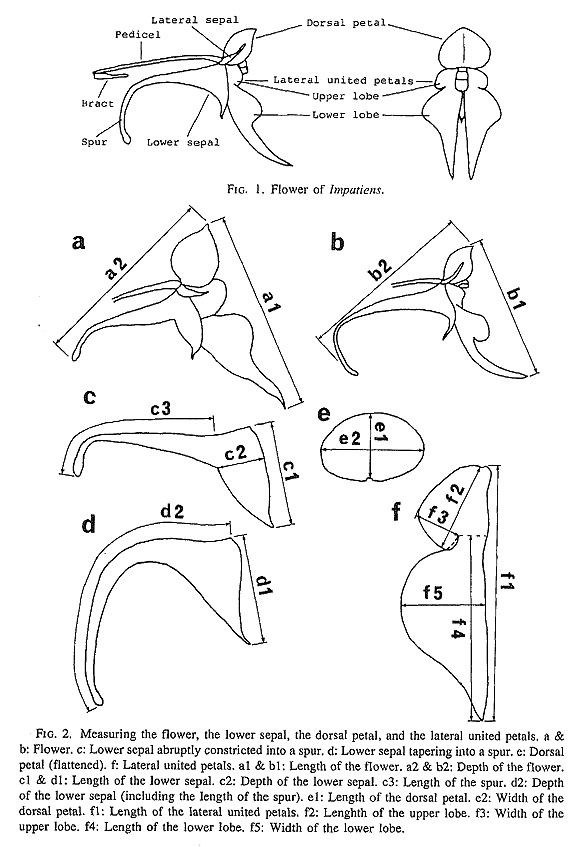

Observations and Discussions
1) Impatiens racemosa DC., Prod. 1: 688 (1824)-Hara in Hara & Williams, Enum. Flow. Pl. Nepal 2: 79 (1979)-Polunin & Stainton, Flow. Himal. 71 (1984). [Colour plates 4d, e; Fig. 4]

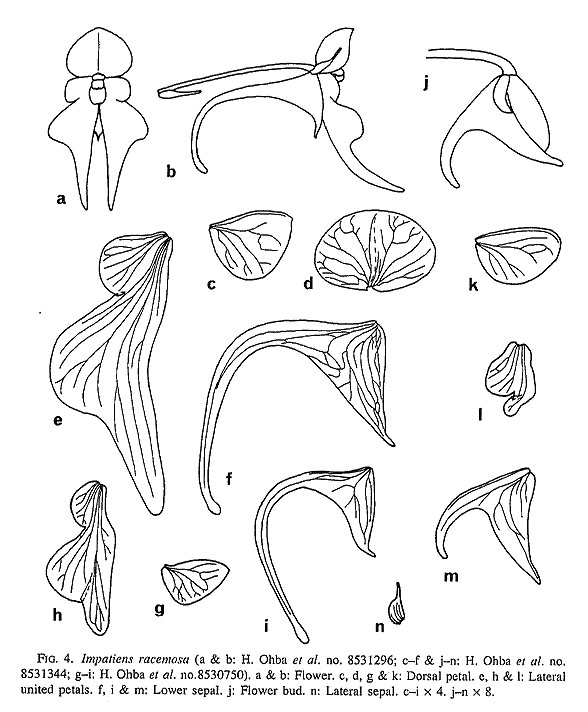
Plants (5-)10-60 cm tall. Leaves alternate, evenly distributed throughout, with petioles 2-15 mm long, lamina broadly lanceolate or oblong-ovate, (1.5-)3-10 cm long, (0.5-)0.8-5 cm wide, apex acuminate, base attenuate, margin crenate, nearly glabrous on both surfaces.
Inflorescence racemose, 2-10 cm long, axilary, with 3-10 flowers. Peduncles 0.5-5 cm long (including the rachis), nearly glabrous. Pedicels slender, 8-18 mm long, nearly glabrous, with a bract at base. Bracts narrowly ovate, 2-4 mm long.
Flowers 10-15 mm long, 12-20 mm deep. Lateral sepals 2, 2-3 mm long, ovate. Lower sepal yellow, navicular, tapering into a long curved spur, 5-8 mm long, 11-18 mm deep including the spur. Dorsal petal yellow, 3-5 mm long and 5-8 mm wide when flattened, cucullate, without a crest-like appendage. Lateral united petals yellow sometimes with reddish dots, 10-18 mm long; the upper lobe ovate, 2-5 mm long, 1.5-3 mm wide; the lower lobe bilobulate with rounded lobes, 7-14 mm long, 4-7 mm wide. Stamens 5, anthers without appendage. Fruits 1.5-1.8 cm long, linear.
Impatiens racemosa is common in Nepal and abundant on path-side banks, in crevices of building, and well characterized by the yellow flowers with red spots, and the boat-shaped lower sepal with a downward curved long spur. Small individuals are only 5-10 cm tall and have only very small flower buds and fruits. These small plants, which have flower buds with rather short spurs and tiny lower lobes of the lateral united petals, are considered to be self-polinating, because the ovaries are already inflated in the flower buds.
2) Impatiens radiata Hook. f. in Fl. Br. Ind. 1: 476 (1875)-Hara in Hara & Williams, Enum. Flow. Pl. Nepal 2: 80 (1979). [Colour plates 4a, b; Fig. 5]

Plants 30-80 cm tall. Leaves alternate, somewhat aggregated at the apical part of the stem, with petioles 5-20 mm long, lamina oblong-ovate or broadly lanceolate, 6-14 cm long, 2-6 cm wide, apex acuminate, base attenuate, margin crenate, nearly glabrous on both surfaces.
Inflorescences interrupted racemes, 7-20 cm long, axillary, with 10-25 flowers. Peduncles 5-8 cm long. Pedicels fascicled or wholed, nearly glabrous, 10-15 mm long, with a bract at base. Bracts ovate, awned, 2-5 mm long including awn.
Flowers 6-8 mm long, 12-16 mm deep. Lateral sepals 2, 1.5-2.5 mm (including awn), ovate, asymmetric. Lower sepal pale yellow or whitish, 6-7 mm long, 10-11 mm deep (including spur), navicular, gradually tapering into a straight spur. Dorsal petal white or pale purple, 3-4 mm long and 3-5 mm wide when flattened, cucullate, without crest-like appendage. Lateral united petals white or pale purple, sometimes with reddish dots, 10-14 mm long; the upper lobe broadly ovate, 2-3 mm long, 2-3 mm wide; the lower lobe bilobed, 8-11 mm long. Stamens 5, anthers without appendage. Fruits 1.5-2 cm long, linear.
Impatiens radiata is similar to I. racemosa, but differs from it mainly by the interrupted inflorescences and white or pale purple flowers. In I. radiata the lower sepal is boat-shaped and tapers into a slender straight spur, while the spur of I. racemosa is conspicuously curved.
3) Impatiens exilis Hook. f. in Rec. Bot. Surv. Ind. 4: 13 & 19 (1905)-Hara in Hara & Williams, Enum. Flow. Pl. Nepal 2: 78 (1979). [Fig. 6]

Plants 10-40 cm tall. Leaves alternate, somewhat aggregated at the apical part of the stem, with petioles 2-10 mm long, lamina broadly lanceolate or oblong-ovate, 3-6 cm long, 1.5-2.5 cm wide, apex acute, base attenuate, margin slightly crenate, hairy with short, thick hairs on upper surface, nearly glabrescence on lower surface.
Inflorescences very short racemose, axillary, borne from the axils of upper leaves, 0.2-0.5 cm long. Pedicels slender, nearly glabrous, 8-10 mm long, with a bract at base. Bracts 2-3 mm long, narrowly ovate with acute apex.
Flowers ca. 1 cm long, 1.5-2.5 cm deep. Lateral sepals 2, ovate, 2-3 mm long. Lower sepal pale purple, navicular, tapering into a long spur, 4-6 mm long, 14-23 mm deep (including the spur); the spur straightly elongated. Dorsal petal red purple, 5-6 mm long and 5-6 mm wide when flattened, cucullate, without a crest-like appendage. Lateral united petals deep red-purple, oblong, 7-8 mm long; the upper lobe oblong, 4-5 mm long, 2-3 mm wide; the lower lobe broadly oblong to oblong, 4-5 mm long and 3-4 mm wide. Stamens 5, anthers without appendage. Fruits fusiform, ca. 1 cm long.
Although Impatiens exilis was characterized by the long slender spur of the lower sepal (Hooker, 1905), the lenth of the spur varies considerably even in an individual (Figs. 6 d & g). It is also characterized by the lateral united petals with the upper lobe similar to the lower lobe in shape and size. It grows at lower elevation and the shape of the flowers is considered to be an adaptation to pollination by moths. This is a unique species without relatives in the Himalaya.
4) Impatiens falcifer Hook. f. in Bot. Mag. 129: t. 7923 (1903)-Hara in Hara & Williams, Enum. Flow. Pl. Nepal 2: 78 (1979)-Polunin & Stainton, Flow. Himal. 70 (1984). [Colour plates 5a, b; Fig. 7]
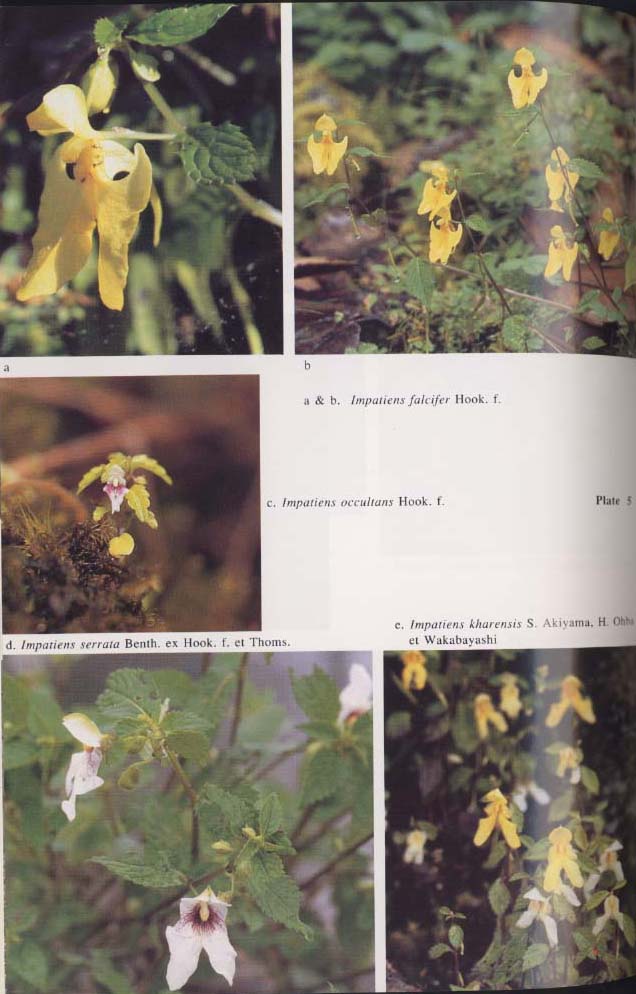
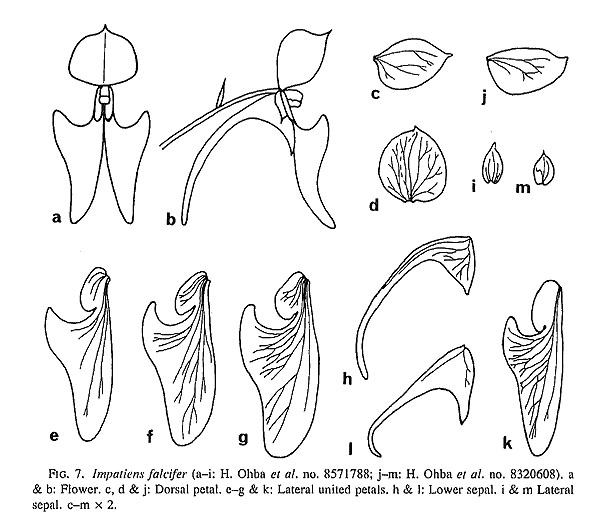
Plants 10-50 cm tall. Leaves alternate, evenly distributed along the stem, with petioles 3-20 mm long, lamina lanceolate or ovate, 2.5-7 cm long, 1-2.5 cm wide, apex acute, base attenuate, margin serrate, nearly glabrous on both surfaces.
Flower solitary, axillary, 2-3 cm long, 2-2.5 cm deep. Pedicel slender 15-20 mm long, glabrous, with a superfluous bract. Bracts narrowly lanceolate, 2-3 mm long.
Lateral sepals 2, ovate, 4-5 mm long. Lower sepal yellow sometimes with reddish veins, 6-8 mm long, 18-25 mm deep (including the spur), navicular, gradually tapering into a slightly curved long spur; the spur about 12-15 mm long. Dorsal petal yellow, ca. 10 mm long, 8-10 mm wide when flattened, cucullate, without crest like appendage, acute at apex. Lateral united petals yellow, central part sometimes with reddish dots, 22-25 mm long; the upper lobe small, elliptic to oblong, 5-6 mm long, ca. 3 mm wide; the lower lobe bilobed, broadly ovate, 16-18 mm long, 8-11 mm wide. Stamens 5, anthers without appendages. Fruits capsulate, linear, 4-6.5 cm long.
Impatiens falcifer is easily distinguished from other species by the pure golden yellow (sometimes red spotted) flowers, the boat-shaped lower sepal with a curved long spur, and the conspicuously bilobed lower lobe of the lateral united petals. It is somewhat similar to I. serrata, especially in having serrate leaves, but differs greatly from it by the small upper lobe of the lateral united petals and the bilobed lower lobe of the lateral united petals.
5) Impatiens serrata Benth. [ex Wall., Cat. 168, n. 4771 (1831)] ex Hook. f. et Thoms. in J. Linn. Soc. Bot. 4: 136 (1860)-Hara in Hara & Williams, Enum. Flow. Pl. Nepal 2: 80 (1979). [Colour plate 5d; Pig. 8]

Plants 20-30 cm tall. Leaves alternate, evenly distributed throughout the stem, with petioles 2-3 mm long, lamina broadly lanceolate or ovate, 20-50 mm long, 7-20 mm wide, apex acute, base attenuate, margin serrate, nearly glabrous on both surfaces.
Flower solitary, axillary, 3.5-4.5 cm long, 1.5-2 cm deep. Pedicel 8-20 mm long, glabrous, with a superfluous bract. Bracts narrowly ovate, ca. 2 mm long. Lateral sepals 2, ovate, ca. 5 mm long. Lower sepal white, navicular, spuriess, 10-13 mm long, 3-5 mm deep. Dorsal petal white, 10-13 mm long and 12-15 mm wide when flattened, cucullate, slightly ridged, without a crest-like appendage, apex cuspidate. Lateral united petals white, in central part and veins deep purple, 2.5-2.8 mm long; the upper lobe nearly deep purple, oblong, ca. 10 mm long, ca. 5 mm wide; the lower lobe nearly white, broadly ovate, apex round, ca. 20 mm long, 10-12 mm wide. Stamens 5, anthers without appendage. Fruits linear, ca. 2 cm long.
Impatiens serrata is well characterized by the serrate leaves, the spuriess lower sepals, and the large rounded upper lobes of the lateral united petals. Flowers white, central parts of the lateral united petals deep purple or red-purple. The size of the flowers is rather constant, though the height of the plants usually varies from 20 to 40 cm and sometimes is less than 10 cm.
Hooker (1915) classified I. serrata, I.falcifer and I. scabrlda in the same group characterized by elongate capsules, bracts between the pedicels, and the rare or absent bract at the base of the pedicel. However, the flowers of these three species are differ greatly in both front and lateral views, and differ in the shape of the lower sepal, dorsal petal and lateral united petals.
6) Impatiens kharensis S. Akiyama, H. Ohba et Wakabayashi1) [Colour plate 5e; Fig. 9]
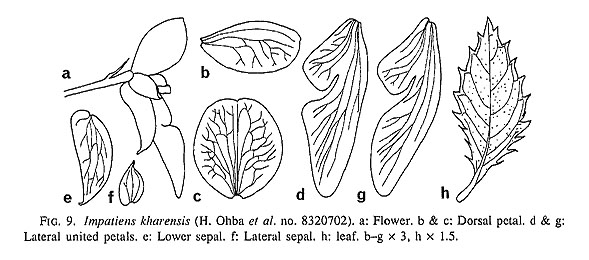
Plants erect, 8-20 cm tall. Stem glabrous. Leaves alternate, evenly distributed along the stem, lamina ovate or broadly lanceolate, 8-15 mm long, 4-6 mm wide, apex acute, base attenuate, margin serrate, nearly glabrous on both surface.
Flower solitary, axillary, 1.5-1.8 cm long. Pedicel 3-5 mm long, glabrous, with a superfluous bract. Bracts narrowly ovate, 1-2 mm long. Lateral sepals 2, ovate, ca. 3 mm long, apex acute. Lower sepal white, navicular, spurless, ca. 8 mm long, ca. 3 mm deep. Dorsal petal white, ca. 8 mm long and ca. 8 mm wide when flattened, cucullate, slightly ridged, without appendage. Lateral united petals white or pale yellow, ca. 15 mm long; the upper lobe oblong, ca. 6 mm long, ca. 3 mm wide; the lower lobe ovate, ca. 10 mm long, ca. 5 mm wide, apex round. Stamens 5, anthers without appendage. Fruits not found. Chromosome number 2n=18.
Impatiens kharensis is similar to I. serrata in vegetative characters, but differs in the shape and size of the flowers (Fig. 9). It is remarkable that these two have
different chromosome numbers; I. serrata is 2n=14, while I. kharensis is 2n=18. The cytological data will be discussed in our forthcoming paper.
7) Impatiens occultans Hook, f. in Rec. Bot. Surv. Ind. 4: 17 & 22 (1905)-Hara in Hara & Williams, Enum. Flow. Pl. Nepal 2: 79 (1979). [Colour plate 5c; Fig. 10]

Plants 3-20 cm tall. Stems more or less succulent, glabrous. Leaves alternate, evenly distributed along the stem, with petioles 3-10 mm long, lamina lanceolate to narrowly ovate, 5-25 mm long, 2-12 mm wide, apex round or acute, base attenuate, margin crenate, sparsely hairy with short hairs on upper surface, nearly glabrous on lower surface.
Flowers solitary, axillary, small, 6-8 mm long, 1-1.5 mm deep. Pedicels 3-8 mm long, glabrous with a bract at middle part. Bract 1-1.5 mm long, narrowly lanceolate. Lateral sepals 4 (2 pairs); the lower pair larger than the other, oblong, ca. 1.5 mm long; the upper ones minute, less than 0.5 mm long. Lower sepal white, navicular, spurless, 2-3.5 mm long, 1-1.5 mm deep. Dorsal petal white, ca. 2.5 mm long and ca.3 mm wide when flattened, cucullate, without a crest-like appendage. Lateral united petals white, shaded red purple in center, 5-7 mm long; the upper lobe broadly oblong-ovate, 1.5-2 mm long, 1.5-2 mm wide; the lower lobe narrowly triangular with acute apex, 3.5-5 mm long, 1.5-2 mm wide. Stamens 5, anthers dehiscent before flowering. Pistil maturing before flowering. Ovary inflated at flowering, breaking the column of stamens. Fruit fusiform, 6-8 mm long.
Impatiens occultans is well characterized by the minute flowers and spurless lower sepal. The flowers reach 8 mm long, and are white except for the purplish central part of the lateral united petals. The lower lobe of the lateral united petals is long triangular with an acute apex. The flowers are considered to be self-pollinating, because the inflated ovary ruptures the column of stamens at flowering.
Impatiens occultans ranges from Sikkim to Nepal. In east Nepal it grows on moist moss-covered rocks or banks mainly in the subalpine Abies spectabilis-forests. It becomes taller in moist places such as rocks by streamsides.
Hooker (1905) classified I. occultans in section BI 8, which he characterized as having a bract at the base (not in the middle part) of the pedicels. In this species the bract is always located in the middle part of a pedicel (Fig. 10 b). This is similar to I. serrata with the superfluous bracts, the solitary flower from an axil and the spurless lower sepals, but differs from it in the shape of the lateral united petals and the leaves and the size of the plants.
8) Impatiens sunkoshiensis S. Akiyama, H. Ohba et Wakabayashi2) [Colour plate 8c; Fig. 11]
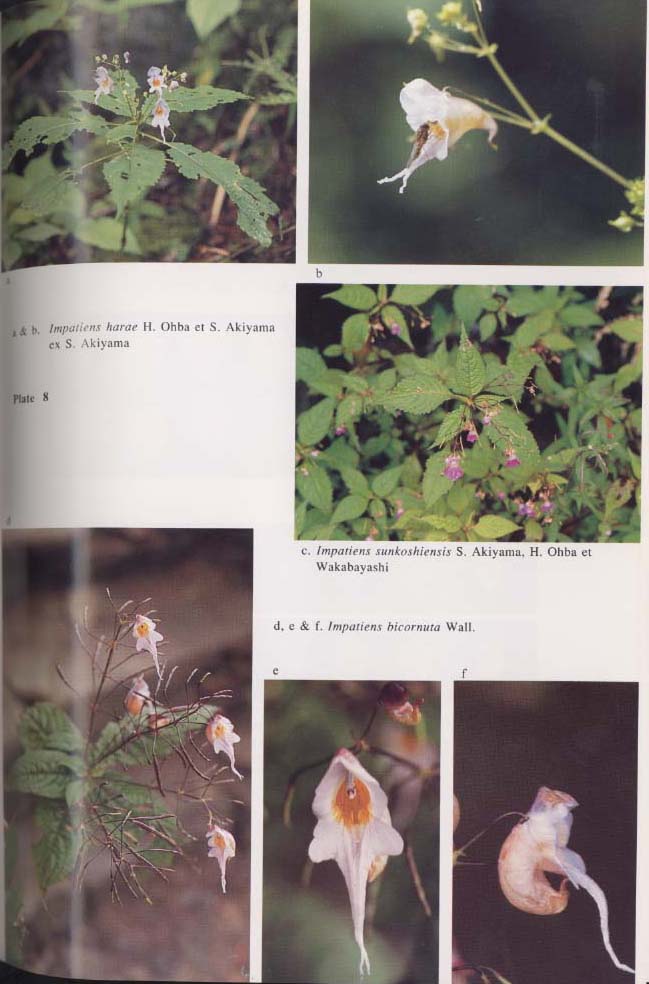
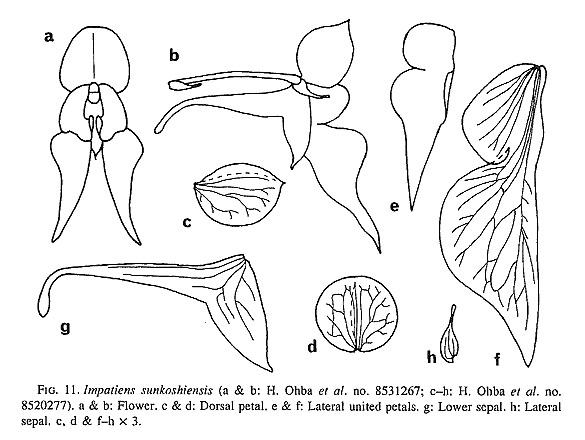
Plants erect, 50-70(-100) cm tall. Stem glabrous with sparse, short glands. Leaves
alternate, more or less aggregate at the apical part of the stem, with glabrous petioles 7-18 mm long, lamina broadly lanceolate or narrowly ovate, 6-8 cm long, 2.4-2.8 cm wide, apex acuminate, base long attenuate, margins minutely crenate, nearly glabrous.
Inflorescence racemose, axillary, aggregated at the apical part of the stem, with 4-7 flowers. Pedicels glabrous, ca. 10 mm long, with a bract at base. Bracts ovate or broadly lanceolate, 3-4 mm long, 1.5-2 mm wide.
Flowers 1.5-1.8 cm long, 1.5-2 cm deep. Lateral sepals 2, oblong, ca. 4 mm long. Lower sepal pale pink, navicular, 6-8 mm long, 2.5-3 mm deep (excluding the spur), abruptly constricted into a straight spur; the spur curved distally, 8-10 mm long. Dorsal petal pale purple, cucullate, ca. 6 mm long and ca. 7 mm wide when flattended, apex rotundate, without appendage. Lateral united petals pink, ca. 20 mm long; the upper lobe rotundate-rectangular, ca. 6 mm long, 5 mm wide; the lower lobe obtriangular or narrowly ovate or semi-orbicular, ca. 14 mm long, ca. 6 mm wide, apex acute. Stemens 5, anthers without appendage. Fruits ca. 2 cm long, linear, glabrous. Chromosome number 2n=18.
Impatiens sunkoshiensis is well characterized by the shallowly boat-shaped lower sepal with a straight spur and the cucullate dorsal petal. The lower lobe of the lateral united petals is narrowly triangular with a cuspidate tip. This is similar to I. gracilifera and I. radiata. Especially in the shape of inflorescense, it is similar to I. gracilifera, but differs from it in the lower sepal with a conspicuous, straight, long spur. It differs from I. radiata in the shorter few-flowered racemose inflorescences and the larger lateral united petals.
9) Impatiens scullyi Hook. f. in Rec. Bot. Surv. Ind. 4: 15 & 21 (1905)-Hara in Hara & Williams, Enum. Flow. Pl. Nepal 2: 80 (1979). [Colour plate 4c; Fig. 12]
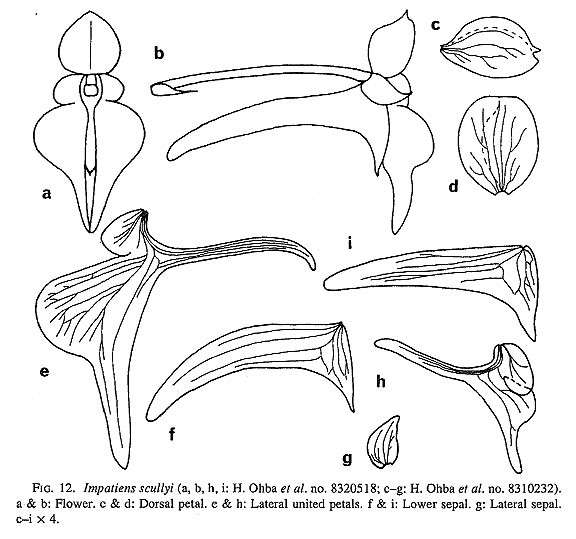
Plants 30-60 cm tall. Leaves alternate, somewhat aggregated at the apical part of the stem, with petioles 5-15(-35) mm long, lamina broadly lanceolate to oblongovate, 8-12 cm long, 4-5 cm wide, margin crenate, nearly glabrous on both surfaces.
Inflorescences racemose, 6-12 cm long, axillary, with 5-10 flowers, flowers congested, with long peduncles (5-8 cm long, glabrous). Pedicels 1.8-2 cm long, slender, glabrous, with a bract at base. Bracts 4-5 mm long, narrowly ovate, acute at apex.
Flowers 1.2-2 cm long, 1.2-2.8 cm deep. Lateral sepals 2, ovate, 3-4 mm long. Lower sepal pale purple or whitish, 5-7 mm long, 12-20 mm deep, tubular; spur inconspicuous. Dorsal petal pale purple or whitish, ca. 6 mm long and ca, 6 mm wide when flattened, cucullate, without crest-like appendage. Lateral united petals purple, 13-16 mm long; the upper lobe ovate, ca. 3 mm long, ca. 2 mm wide; the lower lobe with 2 rounded lobes, 11-13 mm long and 6-7 mm wide, with a long appendage (ca. 10 mm long) elongating into the tubular lower sepal. Stamens 5, anthers without appendage.
Impatiens scullyi is characterized by long appendage of the lower lobe of the lateral united petals. The long appendage is considered to be derived because most Impatiens have no such appendage.
The flower is red-purple with a white tubular lower sepal. The size of the flowers is variable, and the shape and size of the lateral united petals also vary according to flower size.
10) Impatiens cymbifera Hook. f. in Fl. Br. Ind. 1: 474 (1875)-Hara in Hara & Williams, Enum. Flow. Pl. Nepal 2: 78 (1979). [Colour plates 6e, f; Fig. 13]

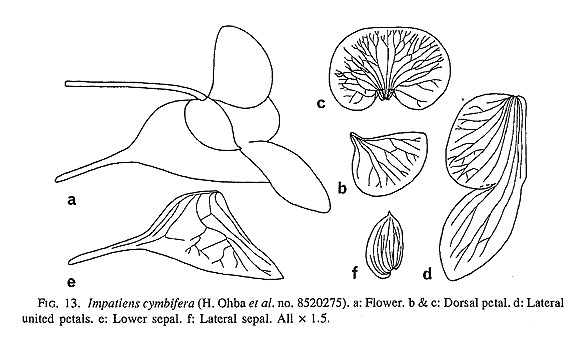
Plants 30-60 cm tall, nearly glabrous. Leaves alternate, more or less aggregate at the apical part of the stem, with petioles (2-)5-20(-35) mm long, lamina oblongovate or broadly lanceolate, 8-15(-17) cm long, (2.5-)4-5(-6.5) cm wide, apex acuminate, base long attenuate, margins minutely crenate, nearly glabrous or sparsely hairy with simple straight hairs on both surface.
Inflorescence racemose, with 3-6 flowers. Pedicels 1-1.5 cm long, with a bract at.base. Bracts narrowly lanceolate, 3-4 mm long, caducous.
Flowers 2.5-3 cm long, 2.5-3 cm deep. Lateral sepals 2, oblong-elliptic to broadly elliptic, glandular tipped, ca. 10 mm long. Lower sepal purple, 15-18 mm long, 10-14 mm deep (excluding the spur), bucciniform, abruptly constricted into a spur; the spur straight, 10-14 mm long. Dorsal petal purple, cucullate, ca. 12 mm long and ca. 20 mm wide when flattened, without crest-like appendage. Lateral united petals purple, 28-35 mm long; the upper lobe very broadly oblong, ca. 16 mm long, ca. 13 mm wide; the lower lobe broadly elliptic, ca. 18 mm long, ca. 10 mm wide. Stamens 5, anthers without appendage. Fruit ca. 2 cm long, linear.
Impatiens cymbifera was first characterized by the large reddish purple flowers with the spurless, cymbiferous lower sepal (Hooker, 1905). Hara (1975) noticed the presence of a spur in the type specimen. Our specimens always have spurred lower sepals, and the spurs are straight, slender, and attaining 14 mm in length.
Hooker (1905) classified three species, I. cymbifera, I. discolor and I. urticifolia, in section BI 6. However, the floral features greatly differ from one to another (Table 1). I. cymbifera is somewhat similar to I. bicornuta and its relatives, but apparently differs from those species in the shape of the flowers and inflorescence. The flower shape, especially in the shape of the lower sepal, is unique and no species resembling it has been found.

11) Impatiens discolor DC., Prodr. 1: 687 (1824)-Hara in Hara & Williams, Enum. Plow. Pl. Nepal 2: 78 (1979). [Colour plates 7d, e; Fig. 14]
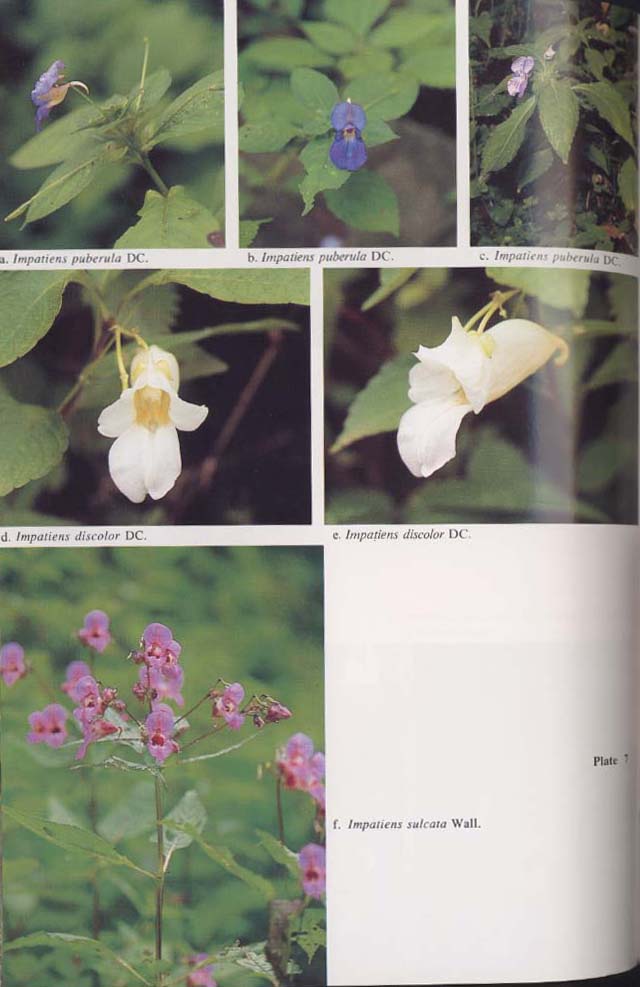
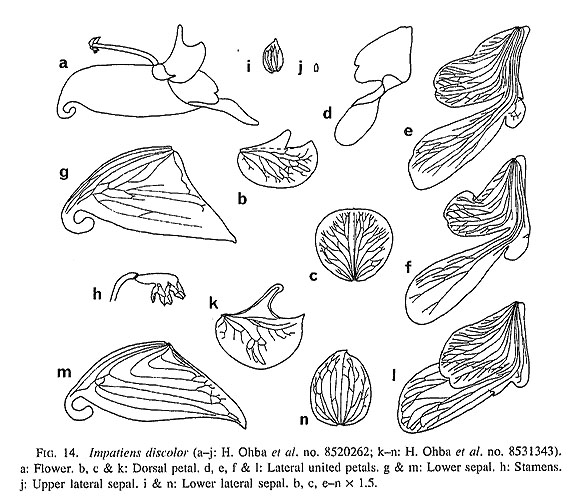
Plants 15-30 cm tall. Leaves alternate, evenly distributed along the stem, petioles (3-)5-15 mm long, lamina narrowly ovate to lanceolate or ovate, 4-9 cm long, 2-4 cm wide, apex acuminate, rarely cuspidate or acute, base attenuate to truncate, margins crenate, sparsely hairy with multicellular hairs on both side.
Inflorescence racemose, axilary, with 2-3 flowers. Peduncles 15-40 mm long including the rachis, glabrous. Pedicels slender, 10-15 mm long, glabrous with a bract at base. Bracts ovate, 2-2.5 mm long.
Flowers 2.3-2.5 cm long, 3-4 cm deep. Lateral sepals 4 (2 pairs) or 2 (1 pair,
the lower pair only), more or less asymmetric in shape; lower two broadly ovate to ovate, glandular tipped, 6-12 mm long; upper ones minute, narrowly ovate, ca. 1 mm long. Lower sepal white, pale yellow or pale pink, bucciniform, 16-20 mm long, 16-20 mm deep (excluding the spur), abruptly constricted into a spur; the spur conspicuously incurved, 10-12 mm in overall length. Dorsal petal white or slightly pink, sometimes shaded yellow, cucullate, 13-15 mm long and 14-18 mm wide when flattened, dorsally with a conspicuous keel-like crest; the crest 3-6 mm high. Lateral united petals white or pale pink shaded pale yellow, 30-34 mm long; the upper lobe broadly oblong, 14-16 mm long, 8-10 mm wide, apex emarginate; the lower lobe oblique, narrowly obovate or oblanceolate with an appendage at inner basal part, apex round or obliquely rounded (sometimes slightly emarginate), 20-23 mm long, 8-10 mm wide. Stamens 5, anthers cuspidate. Fruit 10-15 mm long, fusiform.
Impatiens discolor is distributed in Nepal and Sikkim, and grows on shady soilrich trail-side banks in subalpine Rhododendron arboreum-forests in east Nepal. Impatiens discolor is characterized by the dolabriform lower lobes of the lateral united petals and the cuspidate anthers (Hooker, 1905). It is also remarkable in having whitish or pale yellow (with orange coloured stripes) lower sepals, saccately bucciniform flowers with a short incurved spur, and the helmet-shaped dorsal petals with a conspicuous crest.
The flowers are nearly pure white, sometimes shaded pink, and often have upper pair (Fig. 14j) and lower pair of lateral sepals (Fig. 14i), although Grey-Wilson (1989) described the flowers as basically mauve or purple without the upper pair of lateral sepals.
Hooker (1905) classified I. discolor in section BI 6, with I. cymbifera, I. urticifolia, mainly on the basis of the elongate, linear or clavate capsule, and racemose inflorescence. However, the floral features are greatly different from the others, and I. discolor is evidently related to I. puberula in having a conspicuous crest on the dorsal petal and cuspidate anthers.
12) Impatiens urticifolia Wall. in Roxb., Fl. Ind. 2: 457 (1824)-Hara in Hara & Williams, Enum. Flow. Pl. Nepal 2: 80 (1979)-Polunin & Stainton, Flow. Himal. 70 (1984). [Colour plate 6d; Fig. 15]

Plants 40-80 cm tall, pubescent. Leaves alternate, evenly distributed along the stem, with petioles 5-25 mm long, lamina lanceolate or broadly lanceolate, (5-) 7-12(-15) cm long, 3-4 cm wide, apex acuminate or acute, base long attenuate to attenuate, margins crenulate, nearly glabrous on both surfaces.
Inflorescence racemose, 5-14 cm long, with 3-5 flowers. Peduncles 2-10 cm long including the rachis. Pedicels 15-20 mm long, pubescent, with a bract at base. Bracts narrowly ovate, 3-7 mm long.
Flowers 3-4(-5) cm long, 2.5-3 cm deep. Lateral sepals 4 (2 pairs) or sometimes 2 (the lower pair only); the lower two ovate to broadly lanceolate, 5-6 mm long, with a few glands at margin, gland-tipped; the upper ones, broadly lanceolate, 2-3 mm long. Lower sepal pale yellow or whitish with brownish veins, bucciniform, 20-25 mm long, 12-13 mm deep (excluding the spur), abruptly constricted into a spur; the spur tapering, conspicuously incurved, 13-16 mm in overall length. Dorsal petal pale yellow, cucullate, 10-12 mm long and 14-16 mm wide when flattened, without crest-like appendage. Lateral united petals pale yellow with reddish dots, 26-32 mm long; the upper lobe broadly oblong to nearly square or broadly elliptic, 11-12 mm long, 6-8 mm wide; the lower lobe triangular-ovate to obovate, long or short loriform tailed, 16-20 mm long, 6-7 mm wide. Stamens 5, anthers without appendages. Fruit 2.5-3 cm long, linear.
Impatiens urticifolia is characterized by the large yellow flowers with the long or short loriform tailed lower lobe of the yellow (with red spots and stripes) lateral united petals, the bucciniform lower sepal with an elongate tip and incurving spur, and the helmet-shaped crestless dorsal petal. The length of the elongated tip of the lower sepal is variable, from 1 to 4 mm. Impatiens sulcata has the lower sepal with an elongated tip, but differs from mainly in the cuspidate upper lobe of the lateral united petals.
13) Impatiens scabrida DC., Prodr. 1: 687 (1824)-Hara in Hara & Williams, Enum. Flow. Pl. Nepal 2: 80 (1979)-Polunin & Stainton, Flow. Himal. 70 (1984). [Colour plates 6a, b, c; Fig. 16]
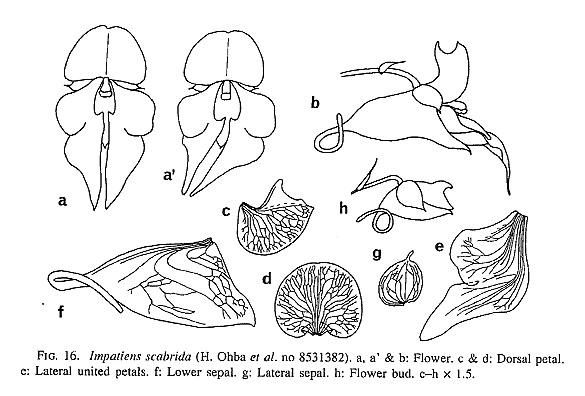
Plants 30-80 cm tall. Leaves alternate, evenly distributed along the stem, with
petioles 5-25 mm long, lamina broadly lanceolate or ovate, 3-8 cm long, 1.5-3 cm wide, apex acuminate or acute, base attenuate, margin serrate, hairy with scabrid hairs on both surfaces.
Inflorescences very short racemose, 0.8-1.5 cm long, with 1-3 flowers. Pedicel slender, sparsely hairy, 10-20 mm long with a bract at mid point. Bracts 3-6 mm long, narrowly ovate with acute apex.
Flowers 2.5-3 cm long, 3-3.5 cm deep, with asymmetric face. Lateral sepals 2, nearly round, ca. 10 mm long, with an awn at apex. Lower sepal pale yellow shaded dull orange, bucciniform, 15-18 mm long, 20-25 mm deep (excluding the spur), abruptly constricted into a incurved spur; the spur 15-23 mm in overall length. Dorsal petal pale yellow, 12-15 mm long and 14-18 mm wide when flattened, cucullate, dorsally with a keel-like crest; the crest 3-5 mm high. Lateral united petals pale yellow, sometimes with brownish stripes, 25-30 mm long; the upper lobe oblong, 13-15 mm long, 7-10 mm wide; the lower lobe ovate with obtuse apex, 13-15 mm long, 6-8 mm wide. Stamens 5, anthers without appendage. Fruits 3-4 cm long.
The flowers of Impatiens scabrida are unique in having lateral united petals asymmetric in front view, conspicuously curved nearly to the mid portion, and with the lower lobes extending left and right in front view (Fig. 16a'). It is also noticeable that the dorsal petal has a crest, and the spur of the lower sepal is rather long and folded or strongly incurved in the middle. This is similar to I. discolor and I. puberula in having crested dorsal petals but differs from them particularly in the shape of the anthers and flowers.
14) Impatiens sulcata Wall. in Roxb., Pl. Ind. 2: 458 (1824)-Hara in Hara & Williams, Enum. Flow. Pl. Nepal 2: 80 (1979)-Polunin & Stainton, Flow. Himal. 70 (1984). [Colour plate 7f; Fig. 17]

Plants stout, (rarely 20-)60-150 cm tall. Leaves more or less aggregated at the apical part of the stem, opposite basally, alternate in the upper part of stem, with petioles 5-15 mm long, lamina elliptic or broadly oblanceolate, 4-10 cm long, 2-4 cm wide, apex acuminate, base attenuate, margins crenate or serrate, nearly glabrous or sparsely hairy with simple straight hairs on both surfaces.
Inflorescences sub-corymbosely racemose, 3-8 cm long, axillary, aggregated in the apical part of the stem, with 3-8 flowers. Peduncles 2-5 cm long, nearly glabrous. Pedicels slender, 12-18 mm long, glabrous, with a bract at base. Bracts ovate, 5-8 mm long with awn.
Flowers 3-3.5 cm long, 3-3.5 cm deep. Lateral sepals 2, oblong-ovate or ovate, apex slightly acute, ca. 7 mm long, ca. 4 mm wide. Lower sepal pale purplish pink, bucciniform, with attenuate and pointed tip, 15-20 mm long, 15-18 mm deep (excluding spur), abruptly constricted into a downwardly curving spur; the spur tapering, 6-8 mm in overall length. Dorsal petal purplish pink, cucullate, 12-15 mm long and 16-18 mm wide when flattened, without crest-like appendage. Lateral united petals pale purple or pink with or without reddish dots, 28-32 mm long; the upper lobe oblong-ovate, apex cuspidate, ca. 14 mm long, ca. 6 mm wide; the lower lobe broadly elliptic or ovate, apex acute, ca. 20 mm long, ca. 10 mm wide. Stamens 5, anthers without appendages. Fruit 2-2.5 cm long, clavate.
Impatiens sulcata is similar to I. bicornuta and I. harae in the shape of the subcorymbose raceme, but the shape of flowers is different. The cuspidate upper lobe of the lateral united petals easily distinguishes it from other species known from
Nepal. Impatiens harae is intermediate in the shape of the flowers between this species and I. bicornuta.
15) Impatiens harae H. Ohba et S. Akiyama ex S. Akiyama in J. Jap. Bot. 62: 368, f. 2D, E (1987), ut 'Harai'. [Colour plates 8a, b]
Var. harae
Plants erect, 50-70 cm tall. Stem glabrous. Leaves alternate, aggregated at the apical part of the stem, with petioles 50-70 mm, lamina elliptic, apex acute, base attenuate, 10-20 cm long, 4-6 cm wide, margins crenate, pubescent on both surfaces.
Inflorescences interrupted racemes, 8-17 cm long, axillary, aggregated at apical part of the stem, with 10-15 flowers. Peduncles 5-12 cm including rachis, glabrous. Pedicels 15-20 mm long, with a bract at base. Bracts broadly ovate, ca. 5 mm long including awn.
Flowers 3.5-4.5 cm long, 2.8-3.3 cm deep. Lateral sepals 2, ca. 4 mm long including awn, broadly ovate, asymmetric, glabrous. Lower sepal bucciniform, 20-24 mm long, 20-24 mm deep (excluding the spur), pale purple, abruptly constricted into a spur; the spur 6-10 mm in overall length. Dosal petal cucullate, pale purple, 9-11 mm long and 15-17 mm wide when flattened, without crest-like appendage. Lateral united petals pale purple with reddish dots in central part, ca. 39 mm long; the upper lobe ovate, ca. 11 mm long, ca. 7 mm wide; the lower lobe bilobed with an appendage at inner basal part, long tailed distally, ca. 26 mm long and ca. 6 mm wide. Stamens 5, anthers without appendages. Fruits ca. 2 cm long, linear.
Impatiens harae is similar to I. bicornuta but differs from it by the bucciniform lower sepals with an abruptly narrowed short spur (Akiyama, 1987).
Var. micrantha (Hara) H. Ohba et S. Akiyama ex S. Akiyama in J. Jap. Bot. 62: 369, f. 2F (1987).
Leaves 13-18 cm long including the petiole.
Flowers 1.3-1.8 cm long, 1.3-1.8 cm deep, self-pollinated. Lower sepal pale purple, ca. 12 mm long, ca. 12 mm deep, bucciniform, narrowed into a spur; the spur straight, 3-4 mm long. Dorsal petal ca. 6 mm long, ca. 9 mm wide, cucullate. Lateral united petals ca. 20 mm long; the upper lobe ovate, 6-7 mm long, ca. 6 mm wide; the lower lobe bilobulate, ca. 13 mm long, 4-5 mm wide.
Grey-Wilson (1989) described two species, I. kaliensis from Kumaon, India and I. arunensis from the Arun Valley, Nepal. These two species are very similar to I. harae and might be synonyms of the latter, though we have not seen the types of the former two.
16) Impatiens puberula DC., Prodr. 1: 687 (1824)-Hara in Hara & Williams, Enum. Flow. Pl. Nepal 2: 79 (1979). [Colour plates 7a, b, c; Fig. 18]

Plants 20-50 cm tall. Leaves alternate toward the apical part of stem, with petioles 5-20(-25) mm long, lamina broadly lanceolate, narrowly oblong-ovate or oblanceolate, 6-15(-18) cm long, 2.5-4(-6) cm wide, apex acuminate, base long or short attenuate, rarely truncate, margins roughly crenate, sparsely hairly with multicellular hairs on both surfaces.
Flowers solitary, axillary, 2.5-3 cm long, 3-3.5 cm deep. Pedicels 25-60 mm long, sparsely pubescent, with a bract at base. Bracts broadly lanceolate, 3-4 mm long.
Lateral sepals 2, suborbicular, glandular tipped, ca. 6 mm long. Lower sepal white or pale pink, bucciniform, tapering into a long spur, 10-12 mm long, 15-20 mm deep (including spur); the spur slightly curved distally. Dorsal petal purple, very widely ovate, 12-15 mm long and 15-20 mm wide when flattened, apex emarginate, dorsally with a keel-like crest; the crest ca. 3 mm high. Lateral united petals purple, 20-22 mm long; the upper lobe suborbicular or nearly square, ca. 8 mm long, ca. 8 mm wide; the lower lobe deep purple, elliptic or broadly oblanceo late, 15-22 mm long, 8-10 mm wide. Stamens 5, anthers cuspidate. Fruit 18-20 mm long, fusiform.
Impatiens puberula is characterized by the large reddish purple flowers with the lower sepals tapering into a straight or distally curving spur, cuspidate anthers and large dorsal petals with a conspicuous crest.
Impatiens discolor is easilly distinguished from I. puberula by the short spurred lower sepals, the wide mouth and the 2-3-flowered racemose inflorescence. Impatiens cymbifera differs in having a raceme and flowers with crestless dorsal petals and larger upper lobes of the lateral united petals.
17) Impatiens bicornuta Wall. in Roxb., Fl. Ind. 2: 460 (1824)-Hara in Hara & Williams, Enum. Flow. Pl. Nepal 2: 78 (1979)-Polunin & Stainton, Flow. Himal. 70 (1984)-S.Akiyama in J. Jap. Bot. 62: 368, f. 2A-C (1987). [Colour plates 8d, e, f]
Plants 60-100 cm tall. Leaves alternate, aggregated at the apical part of the stem, with petioles 5-25 mm long, lamina oblong-ovate or broadly lanceolate, 8-15 cm long, 4-5 cm wide, apex acuminate, base long attenuate, margins crenate, nearly
glabrous or sparsely hairy with short thick hairs on upper surface, sparsely hairy with long or short, straight, simple hairs on lower surface.
Inflorescences interrupted racemes, 10-20 cm long, axillary, aggregated at the apical part of the stem, with 10-25 flowers, pedicels fascicled or wholed, Pedun cules 7-10 cm long. Pedicels 15-25 mm long, with a bract at base. Bracts ovate, 3-5 mm long including awn.
Flowers 3-4.5 cm long, 2.5-2.8 cm deep. Lateral sepals 2, ovate, 4-6 mm long, long awned with a glandular tip. Lower sepal pale purple or yellowish white shaded pale purplish, sometimes with reddish purple dots, saccate, curved sigmoidly downward, 15-20 mm long, 20-25 mm deep (excluding the spur), abruptly con stricted into a spur; the spur 3-4 mm in length. Dorsal petal pale purple with purple dots, cucullate, 10-12 mm long and 14-16 mm wide when flattened, without crest like appendage. Lateral united petals pale purple shaded yellow, 32-40 mm long; the upper lobe ovate, truncate at apex, 11-13 mm long, 7-9 mm wide; the lower lobe bilobed with an appendage at inner basal part, 20-27 mm long, 6-7 mm wide, long tailed distally. Stamens 5, anthers without appendages. Fruits 2-3 cm long, linear.
18) Impatiens pradhanii Hara in J. Jap. Bot. 40: 99 (1965)-S. Akiyama in J. Jap. Bot. 62: 368, f. 1 (1987).
Plants 30-80 cm tall. Leaves alternate, aggregated at the apical part of the stem, with petioles 5-25 mm long, lamina broadly lanceolate or oblong-ovate, 8-15 cm long, 4-6 cm wide, apex acuminate, base attenuate, margins crenate, nearly glabrous or sparsely hairy with short tubercular hairs on upper surface, sparsely hairy with long or short, straight, simple hairs on lower surface.
Inflorescences interrupted racemes, 10-20 cm long, axillary, aggregated at apical part of the stem, with 10-25 flowers. Peduncles 5-8 cm long. Pedicels fascicled or wholed, nearly glabrous, 10-20 mm long, with a bract at base. Bracts ovate, 3-5 mm long including awn.
Flowers 3-4 cm long, 2.5-2.8 cm deep. Lateral sepals 2, ovate, 3-6 mm long, long awned, gland-tipped at apex. Lower sepal pale yellow, saccate, sigmoidly and downwardly curved, 17-20 mm long, 22-25 mm deep (excluding the spur), abruptly constricted into a spur; the spur 3-4 mm long. Dorsal petal pale yellow, cucullate, 10-12 mm long and 14-16 mm wide when flattened, without appendage. Lateral united petals pale yellow with reddish dots, 35-45 mm long; the upper lobe ovate, 10-11 mm long, 7-10 mm wide; the lower lobe bilobed with an appendage at inner basal part, 23-35 mm long, 5-7 mm wide, long tailed at distal end. Stamens 5, anthers without appendage. Fruits 2-2.5 cm long, linear.
Impatiens pradhanii is similar to I. bicornuta but clearly differs from it in the colour of the flowers (Akiyama, 1987).
References
- Akiyama, S. 1987.
- Impatiens bicornuta Wall. and its allied species in Nepal. J. Jap. Bot. 62: 363-370.
- Grey-Wilson, C. 1989a.
- The Impatiens bicornuta and its allies. Studies in Balsaminaceae: VII. Kew Bull. 44: 61-66.
- ———. 1989b.
- The Impatiens jurpia complex. Studies in Balsaminaceae: X. Kew Bull. 44: 115-122.
- Hara, H. 1965.
- New or noteworthy flowering plants from Eastern Himalaya (4). J. Jap. Bot. 40: 97-103.
- ———. 1975.
- Balsaminaceae. In: Ohashi, H. (compiled) Flora of Eastern Himalaya third rep., 78-80. University of Tokyo Press, Tokyo.
- Hooker, J. D. 1905.
- An epitome of the British Indian species of Impatiens. Rec. Bot. Surv. Ind. 4: 1-58.
Appendix 1: Specimens collected by the University of Tokyo Research Teams in 1977, 1983 and 19853).
Impatiens bicornuta Wall.
C Nepal. Phulchoki (2300-2700 m) (H. Ohashi et al., Sept. 16, 1977, no. 771436). Dhaulagiri Zone: Ghandruk (1950 m)-Ghandruk Deorali (2530 m) (H. Ohba et al., July 10, 1983, nos. 8310204 & 8350197). Marsyandi Khola: Chame (2630 m) - Dhanagyang (2200 m) (H. Ohba et al,, Aug. 6, 1983, no. 8311069). Khare Khola: Phedi Kharka (2100 m) Khanigaon (1700 m) (H. Ohba et al., Sept. 14, 1983, nos. 8320726 & 8332089).
E Nepal. Janakpur Zone: Bhandar (2300 m) - Shivalaya (1800 m) (H. Ohba et al., Aug. 6, 1985, no. 8571363); Shivalaya (1800 m)-Bhandar (2300m) (H. Ohba et al., Aug. 17, 1985, no. 8520260). Sagarmatha Zone: Sete (2550 m) - Taktor (3000 m) (H. Ohba et al., Aug. 19, 1985, nos. 8520269 & 8571821); Sarkari Pati (3350 m) - Beni (2350 m) (H. Ohba et al., Sept 3, 1985, nos. 8520389 & 8531273); Beni (2350 m) - Loding (2600 m) (H. Ohba et al., Sept. 4, 1985, nos. 8531297, 8531298 & 8572281).
I. cymbifera Hook. f.
C Nepal. Rolwaling Khola: Simigaon (1950 m) - Kyalche (2700 m) (H. Ohba et al., Aug. 31,1983, no. 8320599).
E Nepal. Redak (2400 m) - Chhurchathanga (3600 m) (H. Ohashi et al., Aug. 9, 1977, nos. 773620 & 773622). Sagarmatha Zone: Sete (2550 m) - Taktor (3000 m) (H. Ohba et al., Aug. 19, 1985, nos. 8520275 & 8571782); Taktor (3000 m) - Mopung (2800 m) (H. Ohba et al., Aug. 20, 1985, no. 8571866).
I. discolor DC.
E Nepal. Chauke (2700 m) - Tute (2300 m) (H. Ohashi et al., Sept. 1, 1977, nos. 771264, 773069 & 774180). Janakpur Zone: Bhandar (2300 m) - Shivalaya (1800 m) (H. Ohba et al., Aug. 6, 1985, no. 8571404); Shivalaya (1800 m) - Bhandar (2300 m) (H. Ohba et al., Aug. 17, 1985, nos. 8520262 & 8571684). Janakpur Zone - Sagarmatha Zone: Bhandar (2300 m) - Sete (2550 m) (H. Ohba et al., Aug. 18, 1985, no. 8571722). Sagarmatha Zone: Sete (2550 m) - Taktor (3000 m) (H. Ohba et al., Aug. 19, 1985, nos, 8520270, 8571818b & 8571823); Pike Dongshar (3600 m) - Namikhil (2300 m) (H. Ohba et al., Sept. 9, 1985, nos. 8520413, 8531343, 8531344b, 8572452, 8572459 & 8572483).
I. exilis Hook. f.
C Nepal. Marsyandi Khola: Jagat (1300 m) - Bahundanda (1300 m) (H. Ohba et al., Aug. 9, 1983, nos. 8320547 & 8331374).
E Nepal. Shemma (1400 m) - Lamobagar (1100 m) (H. Ohashi et al,, Aug. 1, 1977, nos. 770305,771895,773398 & 774632). Dhara Pani (1000 m) - Dharan Bazar (400 m) (H. Ohashi et al., Sept. 5, 1977, nos. 771394 & 774218).
I. falcifer Hook. f.
C Nepal. Phulchoki (2300-2700 m) (H. Ohashi et al., Sept. 16, 1977, no. 771433). Rolwaling Khola: Kyalche (2700 m) - Thandingma (3200 m) (H. Ohba et al., Sept. 1, 1983, no. 8320608).
E Nepal. Topke Gola (3600 m) - Shewaden (2600 m) (H. Ohashi et al., Aug. 21, 1977, nos. 772675 & 775275). Sagarmatha Zone: Sete (2550 m) - Taktor (3000 m) (H. Ohba et al., Aug. 19, 1985, nos. 8520274 & 8571788); around Pike Dongshar (3600-4000 m) (H. Ohba et al., Sept. 7 or 8, 1985, no. 8520405; H. Ohba et al., Sept. 8, 1985, no. 8531342); Pike Dongshar (3600 m) - Namikhil (2300 m) (H. Ohba et al., Sept. 9, 1985, nos. 8531378, 8572498 & 8581485).
I. harae H, Ohba et S. Akiyama ex S. Akiyama var. harae
E Nepal. Janakpur Zone: Neju (3651 m) - Choarma (2760 m) (H. Ohba et al., Aug. 2, 1985, nos. 8520252 & 8530680, TI-holotype); Choarma (2760 m) - Kyama (2600 m) (H. Ohba et al., Aug. 3, 1985, no. 8530740)
Var. micrantha (Hara) H. Ohba et S. Akiyama ex S. Akiyama
E Nepal. Honkon (2400 m) - Chantang (2250 m) (H. Ohashi et al., Aug. 7, 1977, no. 774937).
I. kharensis S. Akiyama, H. Ohba et Wakabayashi
C Nepal. Khare Khola: Bitta Kharka (4100 m) - Patale Pokhari (4000 m) (H. Ohba et al., Sept. 12, 1983, no. 8320702, TI-holotype).
I. occultans Hook.f.
C Nepal. Rolwaling Khola: Beding (3600 m) - Na (4050 m) (H. Ohba et al., Sept. 4, 1983, no. 8320622). Khare Khola: Bitta Kharka (4100 m) - Patale Pokhari (4000 m) (H. Ohba et al., Sept. 12, 1983, no. 8331975).
E Nepal. Chhurchathanga (3200-3600 m) (H. Ohashi et al., Aug. 10, 1977, nos. 770637, 772219 & 773661). Thudam (3400 m) - Lamni Nama (4200 m) (H. Ohashi et al., Aug. 14, 1977, no. 770732). Topke Gola (3600 m) - Chodo Gyabo (4000 m) (H. Kanai & Y. Tateishi, Aug. 20, 1977, nos. 770948 & 775212; H. Ohba, Aug. 20, 1977, no. 772597). Janakpur Zone: Koshing Kharka (4000 m) - Thare Og (4150 m) (H. Ohba et al., July 22, 1985, no. 8570653); around Thare Og (4150 m) (H. Ohba et al., July 23, 1985, nos. 8520179 & 8570746); Neju (3651 m) - east of Neju (H. Ohba & S.K. Wu, July 31, 1985, no. 8530644); around Neju (3651 m) (H. Ohba et al., Aug. 1, 1985. nos. 8520242 & 8571019); Neju (3651 m) -Choarma (2760 m) (H. Ohba et al,, Aug. 2, 1985, no. 8530703). Sagarmatha Zone: Sete (2550 m) Taktor (3000 m) (H. Ohba et al., Aug. 19, 1985, nos. 8520278 & 8571790); Thosa Kharka (3670 m) - Beni Kharka (Dambuk) (3970 m) (H. Ohba et al., Aug. 22, 1985, nos. 8571909 & 8571919); Beni Kharka (Dambuk) (3970 m) - upper DudhKund (4600 m) (M. Wakabayashi et al., Aug. 26, 1985, no. 8520324); around Beni Kharka (Dambuk) (3970 m) (H. Ohba et al., Aug. 31, 1985, no. 8531199); Beni Kharka (3970 m) - Sarkari Pati (3350 m) (H. Ohba et al., Sept. 2, 1985, nos. 8572157 & 8581287); around Pike Dongshar (3600-4000 m) (H. Ohba et al, Sept. 7, 1985, no. 8572427); Pike Dongshar (3600 m) - Namikhil (2300 m) (H. Ohba et al., Sept. 9, 1985, no. 8531381).
I. pradhanii Hara
C Nepal. Marsyandi Khola: Chame (2630 m) - Dhanagyang (2200 m) (H. Ohba et al., Aug. 6, 1983, no. 8320520). Rolwaling Khola: Simigaon (1950 m) - Kyalche (2700 m) (H. Ohba et al., Aug. 31, 1983, nos. 8320598 & 8351176); Kyalche (2700 m)-Thandingma (3200 m) (H. Ohba et al., Sept. 1, 1983, no. 8331704).
I. puberula DC.
C Nepal. Gandaki Zone: Suiket (1230 m) - Pathana (Dhampus) (2050 m) (H. Ohba et al.,
July 7, 1983, no. 8310134). Dhaulagiri Zone: Ghandruk (1950 m) - Ghandruk Deorali (2530 m) (H. Ohba et al., July 10, 1983, no. 8330273); Ghandruk Deorali (2530 m) - Banthanti (2650 m) (H. Ohba et al., July 11, 1983, no. 8320165). Rolwaling Khola: Simigaon (1950 m) - Kyalche (2700 m) (H. Ohba et al., Aug. 31, 1983, no. 8320597). Khare Khola: Phedi Kharka (2100 m) - Khanigaon (1700 m) (H. Ohba et al., Sept. 14, 1983, no. 8320729).
E Nepal. Honkon (2400 m) - Chantang (2250 m) (H. Ohashi et al., Aug. 7, 1977, no. 773538). Janakpur Zone: Jiri (1860 m) - Shivalaya (1800 m) (H. Ohba et al., July 4, 1985, no. 8520003); Choarma (2760 m) - Kyama (2600 m) (H. Ohba et al., Aug. 3, 1985, nos. 8520256, 8530733, 8571170, 8571183 & 8571188); Kyama (2600 m) - Patkare (2200 m) (H. Ohba et al., Aug. 4, 1985, no. 8571256); Shivalaya (1800 m) - Jiri (1860 m) (H. Ohba et al., Aug. 7, 1985, no. 8571465); Jiri (1860 m) - Shivalaya (1800 m) (H. Ohba et al., Aug. 16, 1985, nos. 8571653 & 8580883); Shivalaya (1800 m) - Jiri (1860 m) (H. Ohba et al., Sept. 12, 1985, no. 8531404).
I. racemosa DC.
C Nepal. Kali Gandaki, Tatopani (1360 m) - Ghasa (2100 m) (H. Ohba et al., July 16, 1983, no. 8320246). Rolwaling Khola: Simigaon (1950 m) - Kyalche (2700 m) (H. Ohba et al., Aug. 31, 1983, nos. 8320586 & 8331644); Kyalche (2700 m) - Thandingma (3200 m) (H. Ohba et al., Sept. 1, 1983, nos. 8320609 & 8331736); Thandingma (3200 m) - Beding (3600 m) (H. Ohba et al., Sept. 2, 1983, no. 8331764). Khare Khola: Patale Pokhari (4000 m) - Phedi Kharka (2100 m) (H. Ohba et al., Sept. 13, 1983, nos. 8332044 & 8332067); Phedi Kharka (2100 m) - Khanigaon (1700 m) (H. Ohba et al., Sept. 14, 1983, no. 8320727).
E Nepal. Khandbari (1150 m) - Botebus (1800 m) (H. Ohashi et al., July 27, 1977, no. 771614). Fururu (2050 m) - Num (1600 m) (H. Ohashi et al., July 29, 1977, no. 774549). Lamobagar (1100 m) - above Shinbun (2100 m) (H. Ohashi et al., Aug. 2, 1977, nos. 771937 & 774675). Honkon (2400 m) - Chantang (2250 m) (H. Ohashi et al., Aug. 7, 1977, no. 774836). Redak (2400 m) - Chhurchathanga (3600 m) (H. Ohashi et al,, Aug. 9, 1977, no. 773629). Topke Gola (3600 m) - Shewaden (2600 m) (H. Ohashi et al., Aug. 21, 1977, nos. 770998 & 775287). Surke Pati (2100 m) - Gupha Pokhari (2800 m) (H. Ohashi et al., Aug. 30. 1977, no. 772952). Gupha Pokhari (2800 m) - Chauke (2700 m) (H. Ohashi et al., Aug. 31. 1977, no. 774146). Chauke (2700 m) - Tute (2300 m) (H. Ohashi et al., Sept. 1, 1977, no. 771266). Janakpur Zone: Neju (3651 m) - Choarma (2760 m) (H. Ohba et al., Aug. 2, 1985, no. 8571042); Choarma (2760 m) - Kyama (2600 m) (H. Ohba et al., Aug. 3, 1985, no. 8571185); Kyama (2600 m) - Patkare (2200 m) (H. Ohba et al., Aug. 4, 1985, nos. 8520258, 8530750 & 8571259); Patkare (2200 m) - Bhandar (2300 m) (H. Ohba et al., Aug. 5, 1985, no. 8571336); Jiri (1860 m) - Shivalaya (1800 m) (M. Suzuki et al., Aug. 16, 1985, nos. 8571580 & 8571631); Shivalaya (1800 m) - Bhandar (2300 m) (H. Ohba et al., Aug. 17, 1985, no. 8520259). Sagarmatha Zone: Sete (2550 m) - Taktor (3000 m) (H. Ohba et al., Aug. 19, 1985, no. 8520267); Beni Kharka (3970 m) - Sarkari Pati (3350 m) (H. Ohba et al., Sept. 2, 1985, no. 8572145); Sarkari Pati (3350 m) - Beni (2350 m) (H. Ohba et al., Sept. 3, 1985, no. 8531272); Beni (2350 m) - Loding (2600 m) (H. Ohba et al., Sept. 4, 1985, nos. 8531296, 8531300 & 8572275); Pike Dongshar (3600 m) -Namikhil (2300 m) (H. Ohba et al., Sept. 9, 1985, nos. 8531344 & 8581443).
I. radiata Hook. f.
C Nepal. Rolwaling Khola: Kyalche (2700 m) - Thandingma (3200 m) (H. Ohba et al., Sept. 1, 1983, nos. 8320602 & 8331712).
E Nepal. Hatia Gola (1600 m) - Konkon (2400 m) (H. Ohashi et al., Aug. 5, 1977, nos. 773495 & 774776). Redak (2400 m) - Chhurchathanga (3600 m) (H. Ohashi et al., Aug. 9, 1977, no. 770542). Topke Gola (3600 m) - Shewaden (2600 m) (H. Ohashi et al., Aug. 21, 1977, no. 775287). Janakpur Zone: Neju (3651 m) -Choarma (2760 m) (H. Ohba et al., Aug. 2, 1985, nos. 8530681 & 8571128); Bhandar (2300 m) - Shivalaya (1800 m) (H. Ohba et al., Aug. 6, 1985, no. 8571388); Shivalaya (1800 m) - Bhandar (2300 m) (H. Ohba et al., Aug. 17, 1985, no. 8520261). Janakpur Zone - Sagarmatha Zone: Bhandar (2300 m) - Sete (2550 m) (H. Ohba et al., Aug. 18, 1985, no. 8571718). Sagarmatha Zone: Sete (2550 m) - Taktor (3000 m) (H. Ohba et al., Aug. 19, 1985, nos. 8520268 & 8571822); Sarkari Pati (3350 m) - Beni (2350 m) (H. Ohba et al., Sept. 3, 1985. nos. 8531280, 8531287 & 8572254); Pike Dongshar (3600 m) - Namikhil (2300 m) (H. Ohba et al,, Sept. 9, 1985, no. 8531360).
I. scabrida DC.
C Nepal. Marsyandi Khola: Humde (3320 m) - Bardang (2850 m) (H. Ohba et al., Aug. 4, 1983, nos. 8311019, 8320479 & 8331156). Tamba Kosi: Totlabari (1100 m) - Simigaon (1950 m) (H. Ohba et al., Aug. 29, 1983, no. 8320576). Khare Khola: Khanigaon (1700 m) - Suri Dhoban (1000 m) (H. Ohba et al., Sept. 15, 1983, nos. 8320735 & 8332122).
E Nepal. Janakpur Zone - Sagarmatha Zone: Bhandar (2300 m) - Sete (2550 m) (H. Ohba et al., Aug. 18, 1985. nos. 8520266 & 8571737), Sagarmatha Zone: Pike Dongshar (3600 m) - Namikhil (2300 m) (H. Ohba et al., Sept. 9, 1985, no. 8531344b). Sagarmatha Zone - Janakpur Zone: Namikhil (2300 m) - Bhandar (2300 m) (H. Ohba et al., Sept. 10, 1985, nos. 8520415 & 8531382).
I. scullyi Hook. f.
C Nepal, Dhaulagiri Zone: Ghandruk (1950 m) - Ghandruk Deorali (2530 m) (H. Ohba et al., July 10, 1983, no. 8310232). Marsyandi Khola: Chame (2630 m) - Dhanagyang (2200 m) (H. Ohba et al., Aug. 6, 1983, nos. 8311065 & 8320518).
E Nepal. Janakpur Zone: Shivalaya (1800 m) - Jiri (1860 m) (H. Ohba et al., Aug. 7, 1985, no. 8571452); Jiri (1860 m) - Shivalaya (1800 m) (M. Suzuki et al., Aug. 16, 1985, no. 8571597).
I. serrata Benth. ex Hook. f. et Thoms.
E Nepal. Sagarmatha Zone: Sete (2550 m) - Taktor (3000 m) (H. Ohba et al., Aug. 19, 1985, nos. 8520271 8571812 & 8580990).
I. sulcata Wall.
C Nepal. Gandaki Zone: Thanti (4080 m) - Manang (3550 m) (H. Ohba et al., July 28, 1983, nos. 8310837,8320446 & 8330943). Rolwaling Khola: Kyalche (2700 m) - Thandingma (3200 m) (H, Ohba et al., Sept. l, 1983, nos. 8320606 & 8331691); Thandingma (3200 m) - Beding (3600 m) (H. Ohba et al., Sept. 2, 1983, no. 8331780); Beding (3600 m) - Na (4050 m) (H. Ohba et al., Sept. 4, 1983, no. 8331793).
E Nepal. Sagarmatha Zone: Sete (2550 m) - Taktor (3000 m) (H. Ohba et al., Aug. 19, 1985, nos. 8520276 & 8571778); Taktor (3000 m) - Mopung (2800 m) (H. Ohba et al., Aug. 20, 1985, no. 8571859); Sarkari Pati (3350 m) - Beni (2350 m) (H. Ohba et al., Sept. 3, 1985, nos. 8531279 & 8572218). Sagarmatha Zone - Janakpur Zone: Namikhil (2300 m) -Bhandar (2300 m) (H. Ohba et al., Sept. 10, 1985, no. 8572574).
I. sunkoshiensis S. Akiyama, H. Ohba et Wakabayashi.
C Nepal. Rolwaling Khola: Kyalche (2700 m) - Thandingma (3200 m) (H. Ohba et al., Sept. 1, 1983, no. 8320603 & 8331731); Thandingma (3200 m) - Beding (3600 m) (H. Ohba et al., Sept. 2, 1983, no. 8331765 & 8331781).
E Nepal. Sagarmatha Zone: Sete (2550 m) - Taktor (3000 m) (H. Ohba et al., Aug. 19, 1985, no. 8520277, TI-holotype); Sarkari Pati (3350 m) - Beni (2350 m) (H. Ohba et al., Sept. 3, 1985, nos. 8520390 & 8531267); around Pike Dongshar (3600-4000 m) (H. Ohba et al., Sept. 7, 1985, no. 8572426; Sept. 8, 1985, no. 8520404); Pike Dongshar (3600 m) Namikhil (2300 m) (H. Ohba et al., Sept. 9, 1985, nos. 8572494 & 8581466).
I. urticifolia Wall.
C Nepal. Dhaulagiri Zone: Ghandruk Deorali (2530 m) - Banthanti (2650 m) (H. Ohba et al., July 11, 1983, no. 8310249); Banthanti (2650 m) - Gorepani Deorali (3170 m) (H. Ohba et al., July 12, 1983, nos. 8310312 & 8320187). Rolwaling Khola: Simigaon (1950m) - Kyalche (2700 m) (H. Ohba et al., Aug. 31, 1983, no. 8320601); Kyalche (2700 m) Thandingma (3200 m) (H. Ohba et al., Sept. 1, 1983, no. 8320604); Thandingma (3200 m) - Beding (3600 m) (H. Ohba et al., Sept. 2, 1983, nos. 8331766 & 8331782). Khare Khola: Bitta Kharka(4100m)-Patale Pokhari (4000 m) (H. Ohba et al., Sept. 12,1983, nos. 8320701, 8320703 & 8331976); Patale Pokhari (4000 m) - Phedi Kharka (2100 m) (H. Ohba et al., Sept. 13, 1983, nos. 8351477).
E Nepal. Janakpur Zone: Ramechhap Distr., Jata Pokhari (4220 m) - below Jata Pokhri (3770 m) (H. Ohba et al., July 18, 1985, no. 8570536b); Koshing Kharka (4000 m) - Thare Og (4150 m) (H. Ohba et al., July 22, 1985, nos. 8520151, 8530409, 8530435, 8570713 & 8580402). Sagarmatha Zone: Sete (2550 m) - Taktor (3000 m) (H. Ohba et al., Aug. 19, 1985, no. 8571775); Loding (2600 m) - Pike Bhanjyang (3500 m) (H. Ohba et al., Sept. 5, 1985, nos. 8531308 & 8572315); Pike Dongshar (3600 m) - Nakikhil (2300 m) (H. Ohba et al., Sept. 9, 1985, no. 8531377).






















